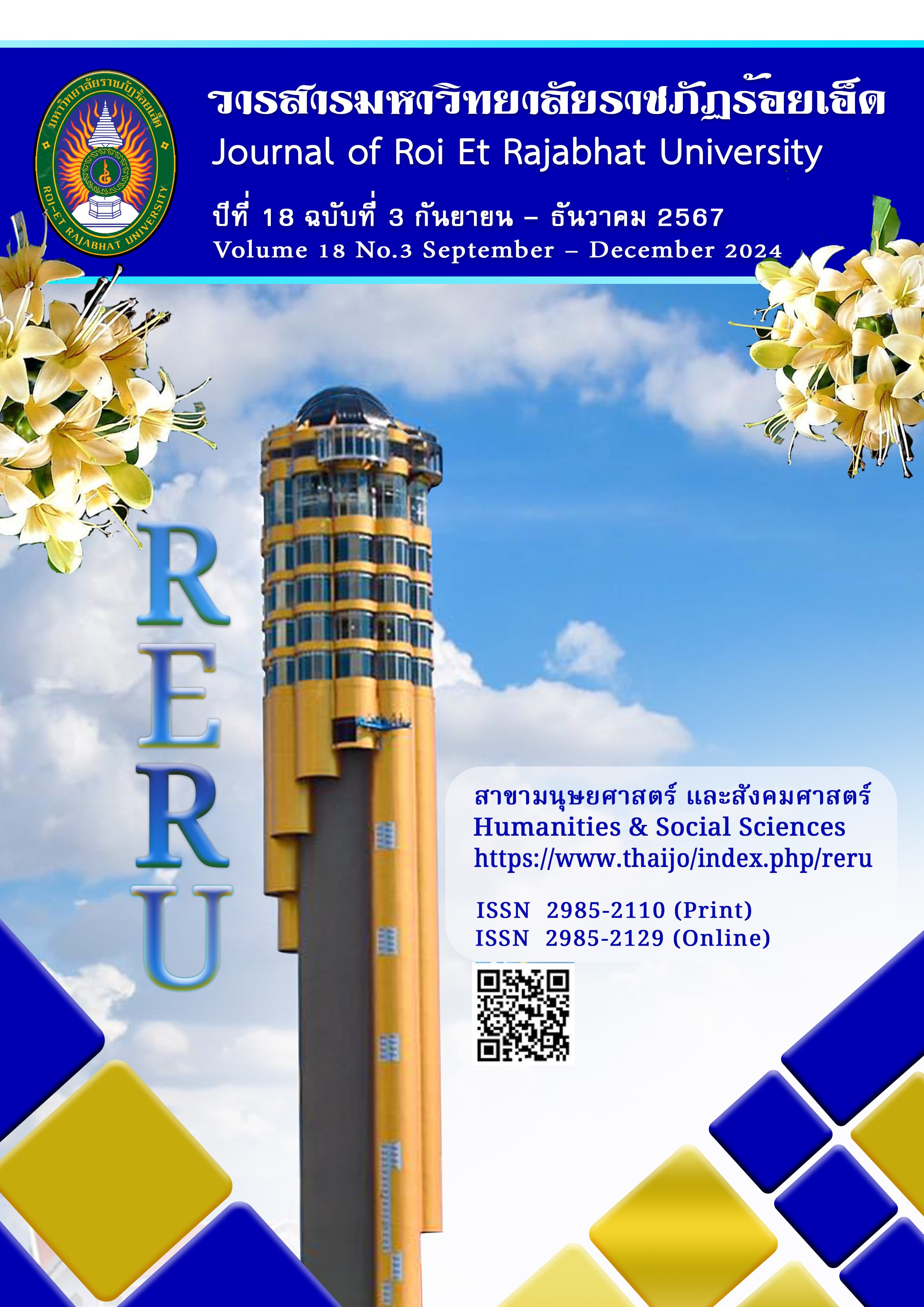Undergraduates’ English Using Community-based Learning to Promote Community Product Oral Presentation Abilities
Keywords:
Community-based learning, Community products, Oral presentationAbstract
This research aims to 1) study the effect of English language learning among undergraduate students using community-based learning on students' presentation skills, and 2) investigate the opinions of community product entrepreneurs on the presentation of community products. The sample for this research consisted of 57 students majoring in English at the Faculty of Education, using a purposive sampling method. The research design is an action research focusing on experiential learning in the form of community-based learning, employing a single-group design and conducting a follow-through planned variation study based on the concepts of Best & Kahn (2006: 184), testing post-instruction against a 70% quantitative passing criterion for the presentation of community products along with quality criteria for community product presentations being at a good level or higher. The research instruments consist of: 1) a lesson plan, 2) an evaluation form for the ability to present community products, and 3) a satisfaction assessment form for the presentation of a video clip about community products in Tha Ma-O. The data were analyzed using descriptive statistics to determine means and standard deviations.
The study found that community-based learning helps the sample students to connect cultural information to the community in their storytelling about community products, achieving a presentation quality at a good level or higher, with an average presentation score of 17.82. The satisfaction evaluation of the video presentation had an average score of 3.73, indicating a high level of satisfaction.
References
กิตติศักดิ์ กลิ่นหมื่นไวย. (2561). แนวทางการส่งเสริมการท่องเที่ยวเชิงวัฒนธรรมชุมชนท่ามะโอ อำเภอเมือง จังหวัดลำปาง. วารสารศิลปะศาสตร์ มหาวิทยาลัยแม่โจ้, 6(1), 131-148.
กัญญาณัฐ สิมสวัสดิ์ (2565). การจัดการเรียนรู้โดยชุมชนเป็นฐาน: กลยุทธ์การจัดการเรียนรู้ในศตวรรษที่ 21 ท่ามกลางสถานการณ์การแพร่ระบาดของเชื้อไวรัสโควิด -19. วารสารวิจัยศรีล้านช้าง, 2(6), 47-55.
เบญจมาภรณ์ ชำนาญฉา และศศิธร คงอุดมทรัพย์. (2563). การศึกษารูปแบบการเรียนการสอนแบบชุมชนเป็นฐาน: ชุมชนบางน้ำผึ้ง กรณีศึกษาของวิทยาลัยเซาท์อีสท์บางกอก. Southeast Bangkok Journal, 6(1), 37-49.
บุญชม ศรีสะอาด. (2560). การวิจัยเบื้องต้น (พิมพ์ครั้งที่ 10). กรุงเทพ: สุวีริยาสาส์น.
ประสิทธิ์ ตึกขาว, ดนุลดา จามจุรี และศิริยุภา พูลสุวรรณ. (2564). การพัฒนารูปแบบการเรียนรู้โดยใช้ชุมชนเป็นฐาน เพื่อเสริมสร้างความสามารถในการใช้ทุนทางวัฒนธรรมอย่างสร้างสรรค์สำหรับนักเรียนระดับมัธยมศึกษา. วารสารศิลปะการจัดการ, 5(3), 718-732.
วไลภรณ์ ฤทธิคุปต์. (2561). การจัดการเรียนรู้โดยใช้ชุมชนเป็นฐาน: กลยุทธ์การจัดการเรียนรู้ที่มีประสิทธิภาพของครูในศตวรรษที่ 21. วารสารบัณฑิตศึกษา มหาวิทยาลัยราชภัฏเชียงราย, 11(3), 179-191.
วิจารณ์ พานิช. (2556). การสร้างการเรียนรู้สู่ศตวรรษที่ 21. กรุงเทพฯ: ส. เจริญการพิมพ์.
สถาบันส่งเสริมการสอนวิทยาศาสตร์และเทคโนโลยี. (2563). คู่มือการใช้ชุดการจัดการเรียนรู้โครงการจัดทำสื่อ 65 พรรษา เฉลิมพระเกียรติ สมเด็จพระกนิษฐาธิราชเจ้า กรมสมเด็จพระเทพรัตนราชสุดา ฯ สยามบรมราชกุมารี ภาคเรียนที่ 2. กรุงเทพฯ: สถาบันส่งเสริมการสอนวิทยาศาสตร์และเทคโนโลยี.
อัจฉรา วงศ์โสธร. (2544). การทดสอบและการประเมินผลการเรียนการสอนภาษาอังกฤษ. กรุงเทพฯ: คุรุสภา.
Bedri, Z., de Frien R. and Dowling, G. (2017). Community-Based Learning: A Primer. Irish Journal of Academic Practice, 6(1), 2-26.
Best, J. W. and Kahn, J. V. (2006). Research in Education. (10th Ed). Boston, MA: Pearson Education.
Bolaños, F., Florez, K., Gómez, T., Ramirez, M. and Tello, S. (2018). Implementing a community-based project in an EFL rural classroom. Colombian Applied Linguistics Journal, 20(2), 274-289.
Cooper, J. (2007). Strengthening the Case for Community-Based Learning in Teacher Education. Journal of Teacher Education, 58(3), 245-255.
Hamilton, E. R. and Margot, K. C. (2019). Preservice Teachers’ Community-Based Field Experiences. Frontiers in Education, 4(115), 1-16.
Lastra, S. Duran, N. and Acosta, D. (2018). Community Based Pedagogy As An Eye-opening for Pre-service Teachers’ Initial Connections with the School Curriculum. Colombia Applied Linguistic Journal, 20(2), 209-229.
Melaville, A., Berg, A. C. and Blank, M. J. (2006). Community-Based Learning: Engaging Students for Success and Citizenship. The Barbara A. Holland Collection for Service Learning and Community Engagement (SLCE) at Digital Commons@UNO. Retrieved March 25, 2023, from https://digitalcommons.unomaha.edu/slcepartnerships/40
Pujiyatno, A. and Rakhmawati, F. (2016). Improving Speaking Ability Through Community-based Learning. Leksika: Jurnal Bahasa, Sastra dan Pengajarannya. 10(2), 20-23.
Tangjitnusorn, K. and Sukavatee, P. (2016). The Effects of Community-Based Instruction Using Hybrid Learning on English Oral Communication for Tourism Industry of Undergraduate Students. Journal of Education Naraesuan University, 18(4), 14-28.
The Partnership for 21st Century Skills. (2010). 21st Century Knowledge and Skills in Educator Preparation. September 2010. Retrieved October 10, 2022, from eric.ed.gov/?id=ED519336
Valette, R. M. and Disick, R. S. (1972). Modern language performance objectives and individualization: A handbook. New York: Harcourt Brace Jovanovich.
Villani, C. J. and Atkins, D. (2000). Community-Based Education. School Community Journal, 10(1), Spring/Summer, 121-126.
Downloads
Published
How to Cite
Issue
Section
License
Copyright (c) 2024 Roi Et Rajabhat University

This work is licensed under a Creative Commons Attribution-NonCommercial-NoDerivatives 4.0 International License.
บทความที่ได้รับการตีพิมพ์เป็นลิขสิทธิ์ของวารสารมหาวิทยาลัยราชภัฎร้อยเอ็ด
ข้อความที่ปรากฏในบทความแต่ละเรื่องในวารสารวิชาการเล่มนี้เป็นความคิดเห็นส่วนตัวของผู้เขียนแต่ละท่านไม่เกี่ยวข้องกับมหาวิทยาลัยราชภัฎร้อยเอ็ด และคณาจารย์ท่านอื่นๆในมหาวิทยาลัยฯ แต่อย่างใด ความรับผิดชอบองค์ประกอบทั้งหมดของบทความแต่ละเรื่องเป็นของผู้เขียนแต่ละท่าน หากมีความผิดพลาดใดๆ ผู้เขียนแต่ละท่านจะรับผิดชอบบทความของตนเองแต่ผู้เดียว





